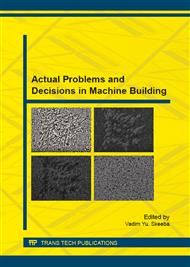[1]
R.W.K. Honeycombe, The Plastic Deformation of Metals. Edward Arnold & American Society of Metals, London, (1984).
Google Scholar
[2]
J.P. Hirth, J. Lothe, Theory of dislocations, N.Y. –St. Louis– San Francisco–Toronto–London–Sydney, (1970).
Google Scholar
[3]
D.V. Lychagin, E.A. Alfyorova, V.A. Starenchenk, Effect of crystallogeometric states on the development of macrobands and deformation inhomogeneity in [] nickel single crystals, Physical Mesomechanics. 14 1-2 (2011) 66-78.
DOI: 10.1016/j.physme.2011.04.009
Google Scholar
[4]
E. Alferova, D. Lychagin, A. Chernyakov, Research of stress field distribution in fcc-single crystal samples in compression, Applied Mechanics and Materials. 682 (2014) 485-490.
DOI: 10.4028/www.scientific.net/amm.682.485
Google Scholar
[5]
Z.G. Kovalevskaya, V.A. Klimenov , K.V. Zaitsev, Interfacial adhesion between thermal spray coating and substrate achieved by ultrasonic finishing, Applied Mechanics and Materials. 682 (2014) 459-463.
DOI: 10.4028/www.scientific.net/amm.682.459
Google Scholar
[6]
V.E. Panin, Physical mesomechanics of solid surface layers, Physical Mesomechanics. 2 6 (1999) 5-20.
Google Scholar
[7]
K. Differt, U. Essmann, H. Mughrabi, Model of extrusions and intrusions in fatigued metal: II. Surface roughening by random irreversible slip, Philosophical Magazine. 54 (1986) 237-258.
DOI: 10.1080/01418618608242897
Google Scholar
[8]
J. Man, P. Klapetekb, O. Man, A. Weidner, K. Obrtlı´k, J. Pola´k, Extrusions and intrusions in fatigued metals. Part 2. AFM and EBSD study of the early growth of extrusions and intrusions in 316L steel fatigued at room temperature, Philosophical Magazine. 89 16 (2009).
DOI: 10.1080/14786430902917624
Google Scholar
[9]
D.V. Lychagin, S. Yu. Tarasov, A.V. Chumaevskii, E.A. Alfyorova, Macrosegmentation and strain hardening stages in copper single crystals under compression, International Journal of Plasticity. 69 (2015) 36-53.
DOI: 10.1016/j.ijplas.2015.01.007
Google Scholar
[10]
K.R. Magida, J.N. Florandob, D.H. Lassilab, M.M. LeBlancb, N. Tamurac, Jr. J.W. Morris, Mapping mesoscale heterogeneity in the plastic deformation of a copper single crystal, Philosophical Magazine. 89 1 (2009) 77-107.
DOI: 10.1080/14786430802558577
Google Scholar
[11]
J. Man, R. Jbrtlik, J. Polak, Extrusions and intrusions in fatiqued metals. Part 1. State of the art and history, Philosophical Magazine & Philosophical Magazine Letters. 16 89 (2009) 1295-1336.
DOI: 10.1080/14786430902917616
Google Scholar


